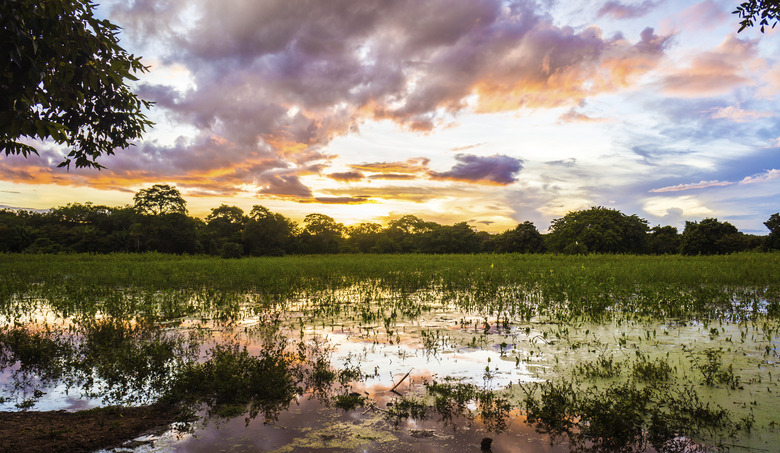Bodies Of Water In The Grasslands
Sweeping grasslands against endless skies are more than picturesque – they are living, breathing habitats. More than 40 percent of land on Earth is covered in these semiarid, virtually treeless landscapes. Also known in various parts of the world as prairies, savannas, steppes, velds, rangelands or pampas, grasslands collectively represent Earth's most altered and endangered ecosystem, thanks in large part to intensified agriculture and development. Bodies of water, most originating from limited rainfall or melting snow, provide essential wildlife habitat in grasslands.
TL;DR (Too Long; Didn't Read)
Streams, vernal pools, playa lakes and prairie potholes are bodies of water found in grasslands.
Grassland Streams
Globally, streams are a critical component of grasslands, providing an essential link to downstream habitat. Compared to other ecosystems, grasslands tend to have more intermittent or seasonal streams, flowing for only part of the year. Highly variable flows resulting from periods of flooding and drought make prairie streams ideal models in disturbance ecology – the study of how ecosystems respond to temporary, but intense, changes in environmental conditions.
Kings Creek in Konza Prairie of northeastern Kansas is one of the planet's most studied grassland streams. Scientists have learned from nearly three decades of work there that prairie streams have excellent water quality and low contaminants, support unique and often endangered species, and control the movement and processing of materials, notably nitrogen, from land to downstream aquatic habitats.
Vernal Pools
Vernal pools are temporary wetlands that form from precipitation in cooler months and dry up in summer. They exist throughout the world in Mediterranean climates but are particularly abundant in and around grasslands on the Pacific Coast. Vernal pools are important to species that depend on a habitat free of predators to raise their young, such as the rare freshwater fairy shrimp and many amphibian species.
In southern Oregon and California, more than 20 threatened and endangered species co-occur in vernal pools. This has prompted the U.S. Fish & Wildlife Service to implement a broad strategy of protecting an entire ecosystem – in this case, all intact vernal pools – as a way to conserve all threatened inhabitants.
Playa Lakes
Flat-bottomed basins known as playas exist in the desert grasslands of Texas, New Mexico, Kansas, Oklahoma and Colorado. Found at the lowest point of a large drainage area, these seasonal, marsh-like ponds collect and store water from rain and runoff.
Unlike vernal pools, playas generally fill when temperatures are unsuitable for plant growth, and often the water is salty, alkali or both. Colorado's eastern plains contain over 2,500 playas ranging in size from one to 50 acres. More than 200 bird species, particularly shorebirds and waterfowl, use these playa lakes.
Prairie Potholes
Roughly 12,000 years ago, the last of the Pleistocene Epoch glaciers retreated from the northern Great Plains, leaving behind an area pockmarked by millions of depressions. These depressions, or potholes, cover a swath of land totaling more than 270,000 square miles, extending from northwest Iowa to central Alberta.
In the spring, the potholes fill with rain and snowmelt, often absorbing excess water that would otherwise contribute to flooding. More than half of North America's migratory waterfowl use these wetlands to rest, nest or breed. Tewaukon National Wildlife Refuge in the heart of North Dakota's prairie pothole region supports upwards of 700,000 snow geese, 2,000 swans and 75,000 ducks during the fall migration.
Cite This Article
MLA
Cozzens, Barbara. "Bodies Of Water In The Grasslands" sciencing.com, https://www.sciencing.com/bodies-water-grasslands-7464691/. 1 May 2018.
APA
Cozzens, Barbara. (2018, May 1). Bodies Of Water In The Grasslands. sciencing.com. Retrieved from https://www.sciencing.com/bodies-water-grasslands-7464691/
Chicago
Cozzens, Barbara. Bodies Of Water In The Grasslands last modified August 30, 2022. https://www.sciencing.com/bodies-water-grasslands-7464691/
